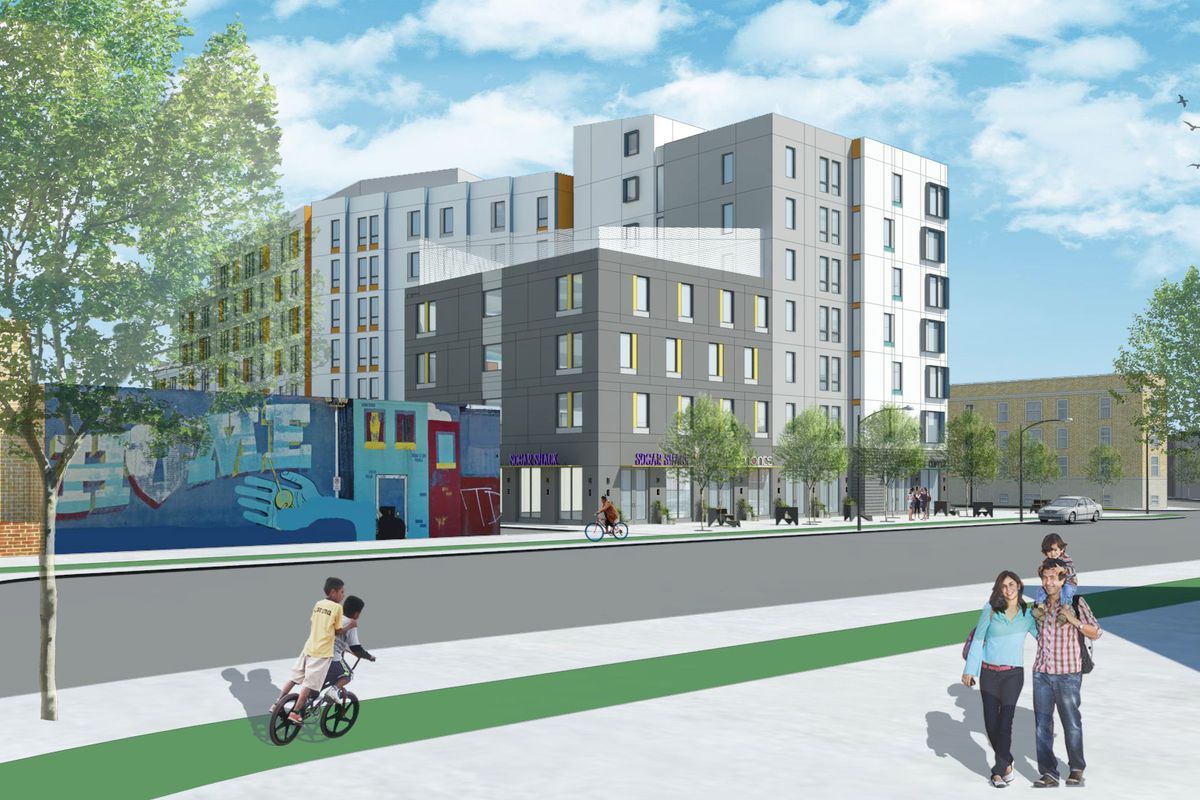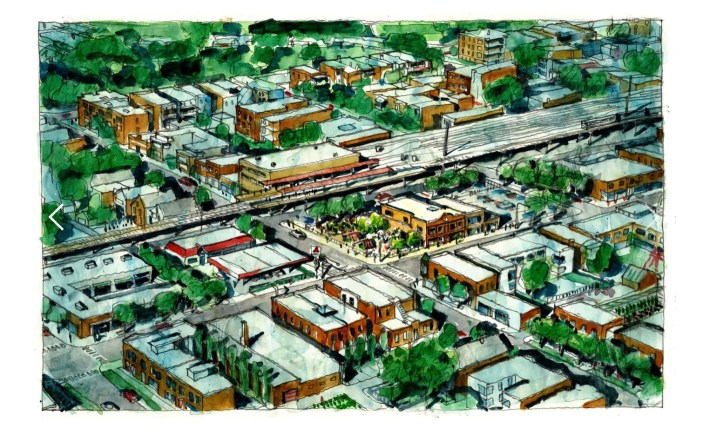Spotlight on equitable transit oriented development at Elevated Chicago symposium
1:54 PM CDT on August 14, 2020

The all-affordable TOD planned next to the Logan Square stop.
Elevated Chicago hosted its virtual 2020 symposium on July 31st, marking the organization’s third year as they continue to focus on equitable transit oriented development (eTOD) around CTA stations. While TOD is focused on land use that encourages housing and businesses around transit nodes, eTOD seeks to address more broadly address displacement and disinvestment around transit.
La Shone Kelly, Garfield Park Community Council’s housing specialist, spoke during the symposium of the importance of eTOD in her community. “Most of our residents are low-income, [so] having affordable housing and healthcare that's easily accessible, being able to get to work without it taking two or three hours, is surmountable because they have other issues already….you're always struggling and you don't see any hope,” Kelly said. "So when I think about equitable transit oriented development, I think there’s relief coming.”
The first session of the symposium discussed how the organization is responding to COVID-19 and systemic racism in Chicago. The symposium opened up with a poem by artivist and Elevated Chicago member Leslé Honoré titled, We have been training for this. Her performance and the rest of the first session can be watched here:
https://youtube.com/watch?v=28n4O1BiPgI&w=560&h=315
The second session was a panel, moderated by Elevated Chicago members Kendra Freeman and Christian Diaz, of community and city stakeholders who are helping form Chicago’s first eTOD policy plan. The 2018 TOD ordinance required the city to produce an eTOD policy plan in order to gauge the impacts of development with regards to displacement and investment.

“Right now in the city of Chicago, more than 90% of transit-oriented development is taking place in the North and the Northwest side, and primarily around the Loop. And in those locations, it can often be a contributing factor to displacement,” Freeman says when discussing the importance of having an equitable policy plan. Diaz emphasized that Chicago is a city that has been “planning for injustice for 200 years”, and only now is the city starting to plan for justice. Although the policy plan focuses on eTOD, Freeman hopes the plan will act as a blueprint for all development across the city to be equitable.
The first panelist Asiaha Butler, president of the Residents Association of Greater Englewood (R.A.G.E.), spoke about the systemic barriers that caused disinvestment in Englewood, such as the closure of schools and the Racine Green Line stop. Specifically, Butler wants us to confront the policies that were rooted in white supremacy and have harmed Black neighborhoods. Instead of planning with the same system and policies that reinforce racism, we should be planning with an entirely new system that begins in a place of justice.
Joshua Wilmoth from Full Circle Communities, an affordable housing developer, agreed with Butler’s point that many of the policy decisions need to be changed so that they start from a justice-based approach. For example, Full Circle Communities has built several affordable housing developments near transit across the Northwest Side. For ones that are federally funded, they go through stricter environmental requirements than market rate developments. Wilmoth says that even this environmental policy with good intentions have made it more difficult to build affordable housing for low-income residents.
Commissioners Marisa Novara for the Department of Housing (DOH) and Maurice Cox for the Department of Planning and Development (DPD) were asked how city government can encourage eTOD across Chicago. Commissioner Novara said that Chicago’s TOD ordinance already encourages development near transit and that effective community engagement is important for those developments to truly benefit residents. Chicago’s low-income tax credits (LIHTC), which help regularly fund affordable housing in the city, were revamped to require developers assess how they will improve racial equity.
Commissioner Cox echoed in agreement with Butler that the city needs to address the racist planning policies that have harmed the South and West Sides, such as urban renewal, the federal highway acts, segregated public housing, and redlining. The commissioner wants to leverage the city’s planning tools to correct these wrongs and plan alongside community members so that residents recognize the power they wield and hold city officials accountable throughout the process.
An affordable housing development on Emmett Street in Logan Square is a great example of eTOD, but faced opposition when first proposed. Even several of Full Circle Communities’ completed and proposed developments on the Northwest Side have been opposed because they would bring “unwanted” residents, which is often code to discriminate against low-income Black and Brown residents. Diaz asked Commissioner Novara and Wilmoth how to desegregate predominately wealthy and white neighborhoods when many residents do not want affordable housing.
Wilmoth spoke how many people travel to and work at Jefferson Park, but even though they contribute to the community fabric, they are not included in local planning matters solely because they do not live in the neighborhood. This particularly harms local low-income workers, who spend a larger share of their income on transportation. Wilmoth argues that there should be a collective planning process where low-income residents’ and workers’ voices are amplified and decisions are not decided by a small, exclusionary community group. Commissioner Novara said that many majority white neighborhoods must realize that they’re in a segregated community and opposing affordable housing perpetuates that cycle. White residents cannot march with Black Lives Matter but oppose efforts to desegregate their neighborhood.
With regards to community planning, Freeman asked Butler what notions from government and private sectors need to be dismantled. Butler brought up that community members need to be respected for knowing how to best support their neighborhood’s needs. R.A.G.E and other Englewood residents have been working on Go Green on Racine, a proposal to bring a fresh market, a repurposing of a former public school, and renovate hundreds of vacant units around 63rd & Racine. The community hopes the development, which recently received a $2.5 million matching grant from the Chicago Prize, will build enough momentum to reopen the Racine station.

Even though Go Green on Racine is an example of a grassroots formed eTOD, Butler said the city hasn’t been a good partner throughout the process. “There is still a notion that we are not subject matter experts of our own communities and when we present an actual equitable transit-oriented development plan that includes housing, also the re-purposing of the vacant schools, and they’re just like ‘oh, no, we hear you, but we're going to do it this way’.”
The city’s eTOD policy plan will be released August 17 th for public input. However, due to the pandemic, community engagement and input around the plan will be more difficult. For the plan to be equitable, the city must center Black and Brown voices in its development before moving forward.
Follow David Zegeye on Twitter at @davidzegeye.
Read More:
Stay in touch
Sign up for our free newsletter
More from Streetsblog Chicago
They can drive 25: Residents, panelist support lowering Chicago’s default speed limit
While there's no ordinance yet, the next steps are to draft one, take a committee vote and, if it passes, put it before the full City Council.
One agency to rule them all: Advocates are cautiously optimistic about proposed bill to combine the 4 Chicago area transit bureaus
The Active Transportation Alliance, Commuters Take Action, and Equiticity weigh in on the proposed legislation.



